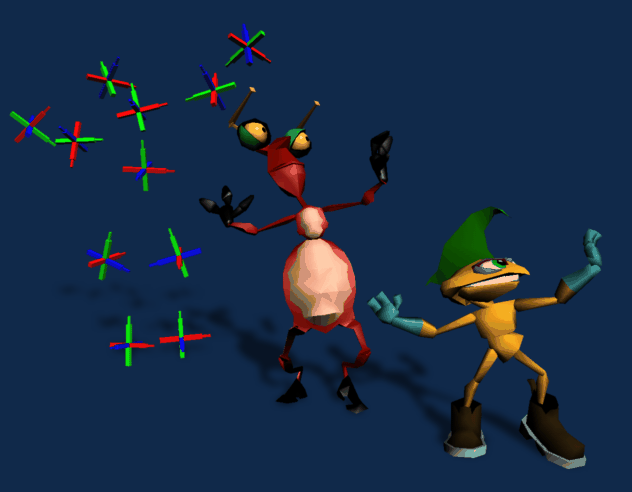

Emre Yilmaz
Protozoa, Inc.
Work discussed here was done with Steve Rein, Dan Hanna, Floops, Mike Morasky, and other characters at Protozoa.
I would like to show that you can do a wider range of work with motion capture than people usually think-- by using it more like puppetry and less like acting.
Floops is an episodic animated cartoon for the web. So far, we've made 40 25-second episodes. SGI webcasts these in VRML2, the 3-D extension of HTML. Working for this application means working within limitations: few polygons, few textures, no morphing, only one full character.
With so many limitations, I wanted to make the character animation as good as possible. The main issue I quickly found myself wrestling with is that Floops is supposed to be a peppy, hyperactive little pet. Motion capture doesn't do this kind of motion easily-- it's realistic, and unexaggerated. How could I get the kind of stylized movements I wanted?
One part of exaggerating Floops' motion was a grab bag of techniques we are developing for characters. I devised a me-to-Floops mapping that exaggerated his limbs while retaining the overall sense of mass in his body. With this, even when I was walking casually across the stage, Floops would bound across it like a 5 year old. These tricks only go so far, and aren't generically usable in all cases. They also have an unfortunate tendency of deadening the original motion a little. So this alone wasn't enough.
Another part was to exaggerate my own movements as I performed. I found it was a big help to think like a puppeteer-- that is, to focus on Floops' movements and ignore my own entirely. (We use a video visor to watch our characters as we perform.) It was not a matter of being casual or performing movements that felt natural, even though you'd think that would always be best with motion capture. What reads well on a person doesn't necessarily read well on a Floops. For that matter, given that I was using an unusual movement mapping, movements wouldn't be 1:1 translated on Floops anyhow. Even though I'm sure I looked silly, the moves looked right to me on Floops.
Another part was stylizing as I performed. I tried to simplify the movement down to its essence, avoiding all inessential movements. This would happen after rehearsing a scene a number of times-- it would start to fall into a pattern, and I'd know where and when every major pose was going to be. I would almost call it "pose-to-pose" planning-- I imagined it felt like dance choreography or keyframe animation. Settling into poses also made it more likely that people would be able to read the movements even at 6 fps.
I was excited to receive mail from a couple of keyframe animators who'd seen Floops, and liked it, but weren't sure whether it was motion capture or keyframe!
You can also do some even stranger mappings. One of our characters is a worm. Your right hand manipulates his head, your left hand his tail, and your feet his mid-segments. This requires real puppeteering skills to do well, but it also takes on a stylization that is fun and interesting, with a very different look than the serious realism of most motion capture. Another example is a series of walking letters that spell out words. To give these a less human, peppier look, I put sensors on a piece of foam rubber, and manipulated that as a puppet, walking it around our stage. Yet another example is a dinosaur character where the performer's right hand performs the puppet's head.
Why would you want to perform its head with your hand, when you can get much better motion off a real head? Well, you can get more realistic motion off a real head, but that's not necessarily better motion. Non-realistic motion can sometimes be a lot more interesting; it has gone through an artistic interpretation. The other reason to do it is that there are some body types you can do with puppetry-- such as the worm-- that are so different from the human shape that there's no other way to do it live.
This is a messy, fuzzy, unscientific process, and not as all-purpose as keyframe animation. Yet, I think this whole grey area has some of the benefits of keyframe animation (exaggerated, stylized movement), while keeping the real-time benefits of motion capture. Maybe it won't be long before we see worms as well as monkeys hosting TV shows.
What's on the videotape:
1) Selected Floops skits, 25 seconds each
- I would probably have to throw out a few of these to fit in 15 minutes.
2) The mapping:
- Part 1: Floops next to the human data
- Part 2: Reggie the Bug next to the same human data
3) Three examples of motion capture puppeteering:
- Worm
- Letters
- Dinosaur
By the time of SIGGRAPH, I anticipate having newer examples to show. So I might replace some of the puppeteering examples here with better ones.
Also on the videotape is stuff I would show if time, or if relevant questions come up in Q+A:
4) "Conscience": Monkey, devil, and angel skit
- This is a counterpoint example of non-stylized, non-exaggerated motion, to show that that kind of motion works fine too and is fun to watch on its own terms.
5) Scary Spider
- This is an example of stylized, but not exaggerated, motion. (Also illustrates procedural puppeteering.)
This article is copyright © 1997 Emre Yilmaz and Protozoa